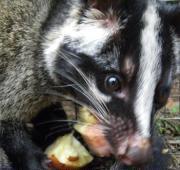 The masked palm civet is a smaller species of civet found throughout the jungles of south-east Asia and across the Indian sub-continent. The masked palm civet is also known as the Himalayan Palm Civet and is most well known to the general public as it is thought to have introduced SARS disease to human inhabitants of the native habitats.
The masked palm civet is a smaller species of civet found throughout the jungles of south-east Asia and across the Indian sub-continent. The masked palm civet is also known as the Himalayan Palm Civet and is most well known to the general public as it is thought to have introduced SARS disease to human inhabitants of the native habitats. The masked palm civet is found inhabiting the tropical jungles and rainforests throughout much of south-east Asia, and throughout India and China. The masked palm civet is also found on a number of the tropical islands surrounding the Asian continent including Taiwan, Borneo and Sumatra. Unfortunately, masked palm civets have been drastically affected by increasing deforestation (and therefore habitat loss) in their native regions.
The masked palm civet is found inhabiting the tropical jungles and rainforests throughout much of south-east Asia, and throughout India and China. The masked palm civet is also found on a number of the tropical islands surrounding the Asian continent including Taiwan, Borneo and Sumatra. Unfortunately, masked palm civets have been drastically affected by increasing deforestation (and therefore habitat loss) in their native regions.
The masked palm civet is widely spread and fairly commonly found throughout much of south-east Asia and despite their cat-like appearance and behaviours, masked palm civets are not felines at all but are in fact more closely related to other small carnivores including weasels and mongooses. The eyes of the masked palm civet are masked by two black bands and are surrounded by a series of white spots.
The masked palm civet is solitary animal that only comes out under the cover of night to hunt and catch food. These nocturnal animals are primarily ground-dwelling and highly terrestrial as they mark their ranges by dragging their anal glands along the ground. Despite being predominately ground-dwelling though the masked palm civet is known to climb up into the trees either in search of food or to hide from approaching predators.
The masked palm civet is a carnivorous animal, and like other species of civet, it survives on a meat-based diet, supplemented by the odd plant or fruit. Small animals such as rodents, lizards, snakes and frogs make up the majority of the masked palm civet's diet, along with insects and other small creatures scuttling through the under-growth. Masked palm civets are also known to eat the fruits and flowers of palms, mangos and coffee in their natural habitats.
Despite being a secretive yet relatively ferocious predatory animals, the masked palm civet is actually preyed upon by a number of predators within their natural environment. Large predatory cats are the most common predators of the masked palm civet including tigers and leopards along with reptiles such as large snakes and crocodiles.
The female masked palm civet usually gives birth to up to 4 young after a gestation period that lasts for a couple of months. The babies are weaned by their mother until they are strong enough to fend for themselves. Masked palm civets can live for up to 20 years, although most rarely get to be this old.
Today, the masked palm civet is under threat from deforestation and therefore drastic loss of much of its natural habitat. The main reason for such extensive deforestation in the area is either for logging or to clear the land to make way for palm oil plantations.

